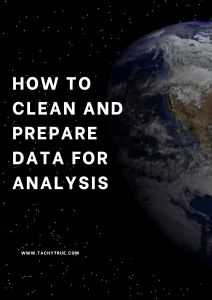How to Clean and Prepare Data for Analysis
Data science, data transfer, digital world, Navigation, Technology, webIntroduction
Data is the lifeblood of modern decision-making, but raw data is rarely ready for analysis. It often contains inconsistencies, errors, missing values, and irrelevant information that can skew results and lead to inaccurate conclusions. The process of cleaning and preparing data for analysis is therefore crucial for ensuring the validity and reliability of any insights derived from it. This article provides a comprehensive guide to data cleaning and preparation, outlining the key steps and techniques involved.

1. Data Collection and Understanding: Laying the Foundation
Identifying Data Sources: Determine the sources of your data, whether it’s from databases, APIs, web scraping, or manual entry. Understanding the origins of your data can help you anticipate potential issues.
Data Profiling: Analyze the structure, content, and quality of your data. This includes examining data types, identifying missing values, and calculating descriptive statistics. Tools like Pandas Profiling in Python can automate this process.
Defining the Scope: Clearly define the scope of your analysis and the specific questions you’re trying to answer. This will help you focus your cleaning and preparation efforts on the relevant data.
Data Dictionary: Create a data dictionary that describes the meaning of each variable in your dataset. This is crucial for ensuring that everyone working with the data has a shared understanding of its meaning.
2. Data Cleaning: Addressing Inconsistencies and Errors
Data cleaning is the process of identifying and correcting errors and inconsistencies in your data. This involves several key steps:
Deletion: Removing rows or columns with missing values. This is only appropriate if the missing data is minimal and randomly distributed.
Imputation: Filling in missing values with estimated values. Common imputation techniques include using the mean, median, or mode, or more sophisticated methods like K-Nearest Neighbors imputation.
Correcting Inconsistent Data: Inconsistent data can arise from various sources, such as typos, data entry errors, or different units of measurement. Correcting inconsistent data involves standardizing formats, correcting spelling errors, and converting units of measurement.
Handling Outliers: They can be caused by genuine extreme events or by errors in data collection. Outliers can be handled by:
Removal: Removing outliers if they are clearly errors.
Transformation: Transforming the data to reduce the influence of outliers. Log transformation is a common technique.
Capping: Replacing extreme values with a maximum or minimum threshold.
Data Type Conversion: Ensure that each variable has the correct data type. For example, dates should be stored as date objects, and numerical values should be stored as numerical types.
3. Data Transformation: Preparing Data for Analysis
Data transformation involves converting data into a format that is more suitable for analysis. Common data transformation techniques include:
Scaling and Normalization: Scaling and normalization techniques, such as standardization (z-score normalization) and min-max scaling, transform numerical variables to have a similar range. This can be important for certain machine learning algorithms.
4. Data Integration: Combining Data from Multiple Sources
Often, data for analysis comes from multiple sources. Data integration involves combining data from these sources into a single, unified dataset. This can be a complex process, especially if the data sources have different formats or schemas. Key considerations for data integration include:
Data Matching: Identifying matching records across different datasets. This can be done using unique identifiers or by comparing values across multiple variables.
Schema Mapping: Mapping variables from different datasets to a common schema. This ensures that the data is consistent and can be easily analyzed.
5. Data Reduction: Simplifying the Data
Sometimes, datasets can be very large, making analysis computationally expensive. Data reduction techniques can be used to simplify the data without losing too much information. Common data reduction techniques include:
Feature Selection: Selecting the most relevant features for analysis. This can be done using statistical methods or by using domain expertise.
Dimensionality Reduction: Reducing the number of dimensions (variables) in the data. Techniques like Principal Component Analysis (PCA) can be used for this purpose.
Sampling: Selecting a subset of the data for analysis. This can be useful for reducing the computational cost of analysis.
6. Data Validation: Ensuring Data Quality
After cleaning and preparing the data, it’s essential to validate the results. This involves:
Checking for Errors: Double-check the data for any remaining errors or inconsistencies.
Visualizing the Data: Create visualizations of the data to identify any unexpected patterns or anomalies.
Comparing with External Data: Compare the data with external sources to ensure that it is consistent.
Domain Expert Review: Have domain experts review the data to ensure that it makes sense and is consistent with their knowledge.
7. Documentation: Keeping Track of the Process
Documenting the data cleaning and preparation process is crucial for reproducibility and transparency. This includes:
Creating a Data Dictionary: As mentioned earlier, a data dictionary is essential for understanding the meaning of each variable.
Conclusion:
Cleaning and preparing data for analysis is a critical but often time-consuming process. By following the steps outlined in this article, you can ensure that your data is accurate, consistent, and ready for analysis. Investing time in data cleaning and preparation upfront will save you time and effort in the long run and will lead to more reliable and meaningful insights. Remember that data cleaning is an iterative process, and you may need to revisit earlier steps as you gain a better understanding of the data. With careful planning and execution, you can transform raw data into a valuable asset that drives informed decision-making and fuels organizational success.
